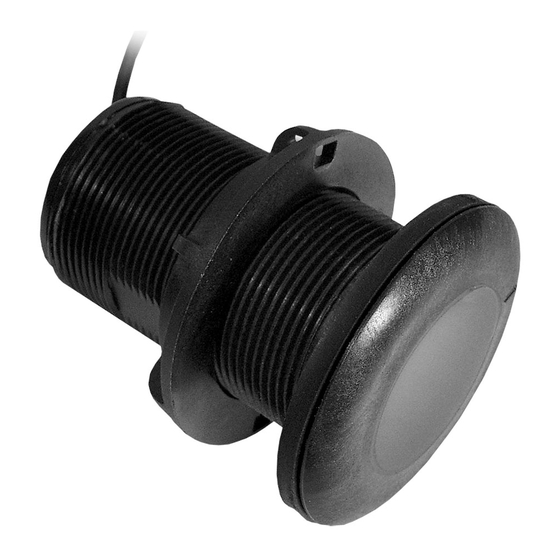
Table of Contents
Advertisement
Quick Links
OWNER' S GUIDE
Thru-hull Depth Transducer
Low Profile, Flush, and Retractable Models
IMPORTANT : Please read the instructions completely
before proceeding with the installation. These
instructions supersede any other instructions in your
instrument manual if they differ.
CAUTION : NEVER USE SOLVENTS!
Cleaners, fuel, paint, sealants, and other products may
contain strong solvents, such as acetone, which attack
many plastics greatly reducing their strength.
Applications
• Plastic housing recommended for fiberglass or metal hulls only.
Never install a plastic transducer in a wood hull, since swelling
of the wood can possibly fracture the plastic.
• Bronze housing recommended for fiberglass or wood hulls.
Never install a bronze housing in an aluminum hull, because
electrolytic corrosion will occur.
• Stainless steel housing compatible with all hull materials.
Recommended for aluminum hulls to prevent electrolytic
corrosion provided the stainless steel housing is isolated from
the metal hull.
• Never install a metal housing in a vessel with a positive ground
system.
Identify Your Model
The model name is printed on the cable tag.
Tools & Materials
Safety goggles
Dust mask
Electric drill with 10mm (3/8") or larger chuck capacity
Drill bit:
3mm or 1/8"
Hole saw (see table opposite)
Countersink tool (installing a flush housing)
Sandpaper
Mild household detergent or weak solvent (such as alcohol)
File (installation in a metal hull)
Marine sealant (suitable for below waterline)
Slip-joint pliers (installing a metal housing)
Zip-ties
Water-based antifouling paint ( MANDATORY IN SALT WATER )
Installation in a cored fiberglass hull (see page 4):
Hole saw for hull interior: (see table on this page)
Fiberglass cloth and resin
or Cylinder, wax, tape, and casting epoxy
&
INSTALLATION INSTRUCTIONS
Record the information found on the cable tag for future reference.
Part No._________________Date___________Frequency________kHz
Low Profile
P319
Mounting Location
Caution : DO NOT MOUNT near water intake or discharge
openings, or behind strakes, fittings, or hull irregularities.
• The water flowing under the hull must be smooth with a
minimum of bubbles and turbulence (especially at high speeds).
• The transducer must be continuously immersed in water.
• The transducer beam must be unobstructed by the keel or
propeller shaft(s).
• Choose a location away from interference caused by power and
radiation sources such as: the propeller(s) and shaft(s), other
machinery, other echosounders, and other cables. The lower
the noise level, the higher the echosounder gain setting that
can be used.
• Choose a location with a deadrise angle of 20º or less, so the
transducer beam will be aimed at the bottom.
• Choose an accessible spot inside the vessel with adequate
headroom for the height of the housing, tightening the nuts, and
removing any insert (see the table below).
Model
Low Profile:
P19, P319,
B117, B619
Low profile:
SS555
Flush:
P219, P269,
B21,
Retractable:
P217, P314,
B17, B21
Retractable:
SS577
Retractable
Low Profile
B17
Flush
P219
Minimum
Outside Hull
Headroom
Hole Saw Size
51 mm or 2"
95 mm (3-3/4")
51 mm or 2"
95 mm (3-3/4")
57 mm or 2-1/4"
in a metal hull
51 mm or 2"
100 mm (4")
200 mm (8")
51 mm or 2"
51 mm or 2"
200 mm (8")
57 mm or 2-1/4"
in a metal hull
Cored Fiber-
glass Hull Only
Hull Interior
Hole Saw Size
60 mm or 2-3/8"
60 mm or 2-3/8"
60 mm or 2-3/8"
60 mm or 2-3/8"
60 mm or 2-3/8"
Advertisement
Table of Contents

Subscribe to Our Youtube Channel
Summary of Contents for Airmar P19
- Page 1 Countersink tool (installing a flush housing) Low Profile: Sandpaper 51 mm or 2" 60 mm or 2-3/8" P19, P319, 95 mm (3-3/4") B117, B619 Mild household detergent or weak solvent (such as alcohol) 51 mm or 2" File (installation in a metal hull) Low profile:...
- Page 2 Best location for transducer threads to seal the hull and to hold the hull nut securely in place. Copyright © 2005 Airmar Technology Corp. Stainless steel housing in a metal hull —To isolate the stainless steel housing from the metal hull, slide the isolation ring onto the...
- Page 3 Airmar’s splash-proof Junction Box No. 33-035 and follow the instructions provided. Removing the water-proof connector or stainless steel housing in metal hull cutting the cable, except when using Airmar’s junction box, will (SS555 shown) void the transducer warranty. 1. Route the cable to the instrument, being careful not to tear the...
- Page 4 6. Sand and clean the area around the hole, inside and outside, to ensure that the marine sealant will adhere properly to the hull. If email: sales@airmareurope.com AIRMAR ® 35 Meadowbrook Drive, Milford, New Hampshire 03055-4613, USA TECHNOLOGY CORPORATION www.airmar.com ■ Copyright © 2006, 2007 Airmar Technology Corp. All rights reserved.
















Need help?
Do you have a question about the P19 and is the answer not in the manual?
Questions and answers